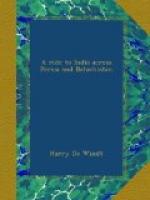Early next morning came a message from Prince Kumal, inviting me to visit the caves of Shahr-Rogan, an excavated village of great antiquity, about ten miles from Beila. I gladly accepted. The camels were tired; the men of the caravan unwilling to proceed for another day, and time hung heavily on one’s hands, with nothing to vary the monotony but an occasional shot at a wood-pigeon (which swarm about Beila), or a game of ecarte (for nuts) with Gerome.
The caves were well worth a visit. I could gain no information at Beila, Quetta, or even Karachi, as to the origin of this curious cave-city, though there can be no doubt that it is of great antiquity. Carless the traveller’s account is perhaps the most authentic.
“About nine miles to the northward of Beila a range of low hills sweeps in a semicircle from one side of the valley to the other, and forms its head. The Purali river issues from a deep ravine on the western side, and rushes down (in the wet season) about two hundred yards broad. It is bounded on one side by steep cliffs, forty or fifty feet high, on the summit of which is an ancient burial-ground. Following the stream, we gained the narrow ravine through which it flows, and, turning into one of the lateral branches, entered Shahr-Rogan.”
Here, on the day in question, Prince Kumal called a halt. A couple of small tents were pitched, and a meal, consisting of an excellent curry, stewed pigeons, beer, and claret, served. Leaving the Prince to amuse himself and delight his followers with his skill in rifle-shooting at a mark chalked out on the rocks, I continued my explorations. The result is, perhaps, better explained to the reader in the words of an older and more experienced observer. Carless says—“The scene was singular. On either side of a wild broken ravine the rocks rise perpendicularly to the height of four or five hundred feet, and are excavated, as far as there is footing to ascend, up to the summit. The excavations are most numerous along the lower part of the hills, and form distinct houses, most of which are uninjured by-time. They consist, in general, of a room fifteen feet square, forming a kind of open verandah, with an interior chamber of the same dimensions, to which admittance is gained by a narrow doorway. There are niches for lamps in many, and a place built up and covered in, apparently to hold grain. Most of the houses or caves at the summits of the cliffs are now inaccessible, from the narrow precipitous paths by which they were approached having worn away. The cliffs are excavated on both sides of the valley for a distance little short of a mile. There cannot be less than fifteen hundred of these strange habitations.”




